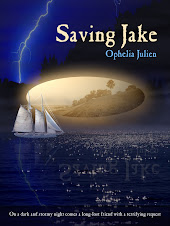Recently when Jim and I went up to Door County with friends, another couple, we visited a place called the Noble House in Fish Creek. Now, the Noble House dates back to 1875 and is disturbed enough to earn it a spot on the Door County Ghost Tour.
But that's an aside
When we toured the Noble House, it was to check out their newest exhibit, "A House in Mourning." What that means is that the entire house was furnished and decorated the way it would have been if someone died there during the Victorian Era. The exhibit was quite something and I'm really, really glad we went during the day.
As expected, all of the mirrors were covered in black cloth, the windows were covered with black curtains, and the clocks had been stopped at the time of death. But there was so much more. In one of the upstairs bedrooms, an array of appropriate mourning wear for the ladies was on display. All of it was black, and all of it was lovely, some with intricate bead work along the sleeves and bodice, and lace at the cuffs or collars. The dresses were authentic, so no touching was allowed, but they could be examined closely to see the details. Widows were required to wear mourning for two years after the death of a husband. No word on how long the guys wore mourning. Besides, they had it easy: a black band around the arm and that was that. At one point, the concept of "lachrymal bottles" was introduced. These little vials were used to catch the tears of a grieving individual and since the stopper at the top was perforated, when all of the tears in the bottle had evaporated, the person was allowed to stop mourning. The informational card alongside this display suggested it was to replace the rather rigid time-rules that had been in effect up to that point.
By the way, all those rigid rules of mourning were effective because people at that time were very superstitious and breaking any of these rules, they believed, meant that they would die. Seriously. It was the running theme of the tour: "And if you didn't do this, then you would die."
But on to the rest of the tour.
There was a special holder on display so that those who stopped in could leave calling cards. There was also a display of the hair jewelry that was made from, of course, the deceased's hair. This included brooches and rings and lockets. All of it was very ornate and actually pretty, although I doubt very much that this particular tradition is about to catch on again. Back in the day, there was even a special tool used to collect the hair and then spin it into a sort of thread or yarn so that it could be worked with more easily. Who knew?
One of the backrooms featured an actual embalming table. Funeral homes didn't exist yet, so people would embalm their loved ones themselves using commercially prepared (and sold) embalming fluid. This particular house was set up so that a portable table could be used. Most people just embalmed their loved ones on the kitchen table. I'd say YIKES! but that moment is coming up a little later.
The front parlor, which was only used for very special occasions such as Christmas, Easter, and wakes, had an actual coffin on display. It was a closed casket, as was the custom back then, although before it was closed, the portrait of the deceased might be taken as it reposed in the casket. There was an abundance of flowers - the wealthier the person, the more flowers present. And the better to disguise the smell.
Here's the little tidbit that took us all aback the most, though, I think. Beyond the home embalming, the hair jewelry, and the memento mori photographs, there was the little-known fact that after the person was embalmed, particularly on the kitchen table, the family would sit at that table and eat a small meal. With the body in the center. YIKES!!!! We all looked at the tour guide as if she had suggested that the coffin would be transported by broomstick to the cemetery with an escort of flying monkeys. But no, she reassured us that this had been A THING. A small meal was eaten around the table where the body reposed.
As a parting treat at the end of the tour, she produced a copy of a photo (that had been taken by someone who I'm guessing was on a ghost tour) that showed a face looking out of a second-story window when no one was up there. Jim and I took that ghost tour years ago and got our own weird picture of a face in the mirror, this one when Jim snapped a shot in one of the upstairs bedrooms. Obtaining such an image in that particular bedroom is a common occurrence. (And no, it's not a reflection of the person taking the picture, because to get the shot, one usually stands in the doorway and out of direct line with the mirror.)
The House in Mourning Tour was fun and informative, and there are things I will always remember. Like eating at the same table as an embalmed body, so I'm glad we stopped in that afternoon. And I'm also really glad that it WAS afternoon, a bright, sunny, summer afternoon. Because even on days like that, whether in mourning or not, The Noble House has very dark corners.





No comments:
Post a Comment